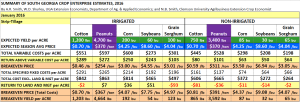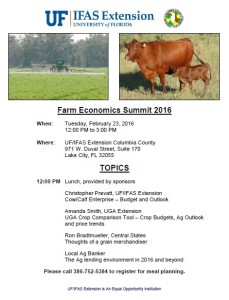Crop farmers across the USA are singing the blues as they wrap up their crop sales and accounting for the season. Locally, it appears there isn’t a crop farmer that I’ve talked to that didn’t have some struggles on one farm or another; either weather, pest, or equipment, that dinged overall yields. When coupled with the lowest prices for most commodities since 2010, the result is tough economic conditions on the farm. Things are not looking any better as we make plans and compare options for 2016. Farmers are concerned about profitability, and their lenders and suppliers are equally concerned.
The University of Georgia recently released an updated version of the 2016 Crop Comparison Tool. This is a snapshot of predicted revenue and expenses. The actual values are obviously farm specific. However, they include a good estimate of typical yields and costs. One concern that we always have is that land rent is not reflected in the expenses. According to the most recent USDA release; in Florida, the average rent for irrigated cropland is $200 per acre. Additionally, the average for non-irrigated land is $60 per acre. It is important for most producers to include this in their estimates as well. It is easy to see why economic conditions for 2016 look challenging.
Considering the importance of the agricultural profitability, we are planning a program for February 23, 2016 dubbed the Farm Economics Summit. This will be an opportunity to learn about both Crop and Cattle Budgets and Outlooks for 2016 and beyond. Speakers include economists, grain merchandisers, and bankers. I hope you will consider joining for lunch and a discussion about the current economic climate in the farm community. Please RSVP at 286-752-5384.


